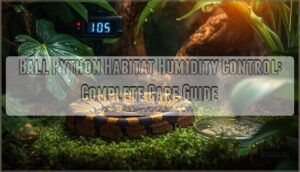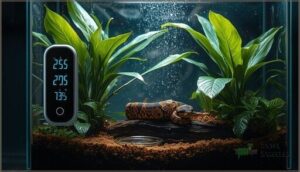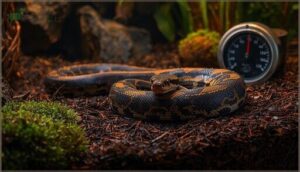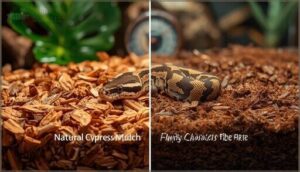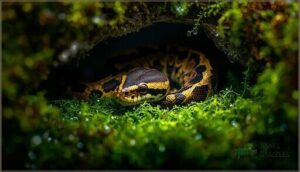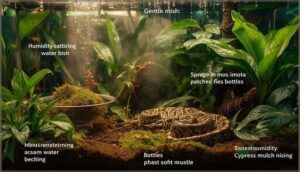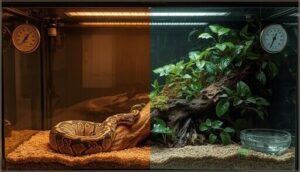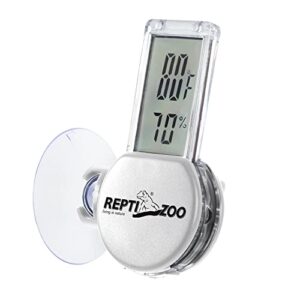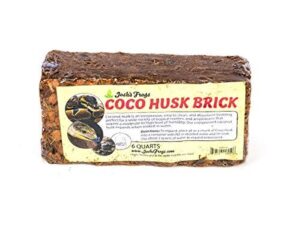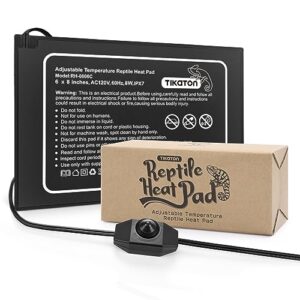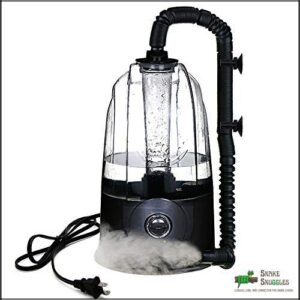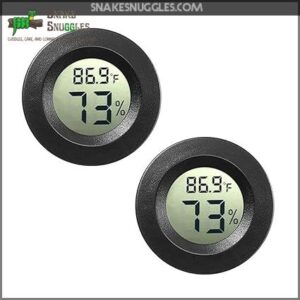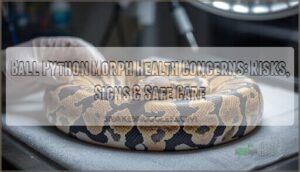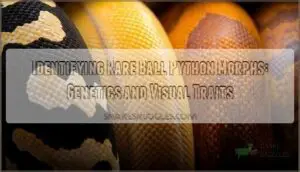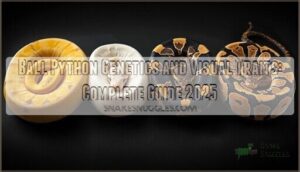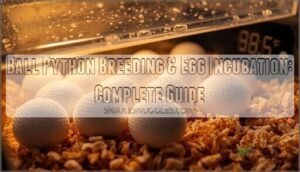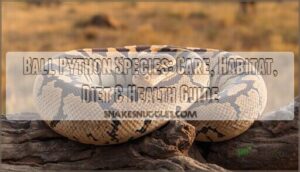This site is supported by our readers. We may earn a commission, at no cost to you, if you purchase through links.
A ball python knows when the air is right. In the wild, humidity spikes after sunset—sometimes hitting one hundred percent. Most keepers miss just how vital those silent changes are.
Set your snake in a tank with the wrong moisture and you’ll quickly see the toll: dry sheds, restless burrowing, even a respiratory rattle at night. Ball python habitat humidity control isn’t a set-and-forget chore; it’s the heartbeat of their environment.
Get this right and everything else falls into place—shed cycles smooth out, health checkups look brighter, and your python feels more at home than ever.
Table Of Contents
Key Takeaways
- Keeping daytime humidity at 50–60% and bumping it up to 60–80% at night closely matches your ball python’s natural environment and prevents common health problems.
- A reliable digital hygrometer and well-placed sensors on both warm and cool sides are essential for accurate, daily monitoring of humidity levels.
- Moisture-retentive substrates like cypress mulch, coco fiber, and sphagnum moss in hides make it easier to maintain stable, healthy humidity and support effortless shedding.
- Using adjustable misting, foggers, and covering most of the tank’s screen top lets you quickly correct humidity drops or spikes while keeping airflow safe.
Ideal Humidity Levels for Ball Pythons
Getting the humidity right in your ball python’s enclosure isn’t guesswork—it’s about hitting specific numbers that keep your snake healthy and comfortable. You’ll need to maintain different levels during the day, at night, and especially when your python is shedding.
Let’s break down exactly what those numbers should be and what happens when humidity goes off track.
Recommended Humidity Range (Day and Night)
Your ball python needs different humidity levels as the sun rises and sets, just like in the wild. During the day, aim for 50% to 60% humidity—this matches what captive care standards recommend. At night, bump that range up to 60% to 80%. Wild humidity levels in African habitats can spike to 100% after dark, so short-term deviations won’t harm your snake if you’re monitoring methods stay consistent. To support their well-being, annual vet visits are key to monitor ball python health.
- Digital hygrometers track real-time humidity control across your enclosure
- Place sensors on both warm and cool sides for accurate humidity range readings
- Log daily minimums and maximums to spot patterns in your ball python’s environment
Humidity Needs During Shedding
When your ball python enters a shed cycle, you’ll need to raise humidity from the standard 50–60% range up to 70–85%. Juvenile needs are higher since shedding frequency hits every 4–6 weeks.
In natural burrows, humidity during shedding approaches 99%, so a humidity hide filled with moist sphagnum moss mimics that environment and prevents stuck sheds below 60%.
To manage shedding effectively, understanding shedding treatment options is vital for the health of your ball python.
Risks of Incorrect Humidity
Letting humidity levels wander too far can stir up real trouble—respiratory issues and dehydration risks quickly show up when things get too dry, while excessive humidity fosters fungal growth and persistent skin problems. If you notice stuck shed or odd breathing, it’s a sign your humidity control needs a tune-up.
When humidity strays too far, your ball python faces dehydration, respiratory trouble, and fungal skin problems you can’t ignore
Remember, ideal humidity for ball pythons means fewer complications all around.
Measuring and Monitoring Humidity
Getting humidity right starts with reliable tools and good habits. Keeping tabs on moisture in your ball python’s habitat isn’t guesswork—it’s measured and monitored every day.
Here’s how you can make sure your setup meets your snake’s needs.
Choosing Accurate Hygrometers
Wondering why your python’s shed is patchy? Choosing the right humidity gauge is your first move. Digital hygrometers outperform analog for stable humidity tracking. Here’s what to compare:
- Sensor accuracy—digital wins every time
- Device comparison before install
- Regular calibration methods
- Features for ongoing humidity monitoring
Go digital for reliable results.
Placement of Humidity Sensors
Inside your enclosure, probe placement makes or breaks humidity monitoring. Place digital hygrometers centrally, about two inches above the substrate, to capture humidity gradients without bias from heat or water sources. Split sensors across hot and cool sides for microclimate monitoring—calibrate often for the best readings. Mind enclosure design, and your humidity gauge shows the real picture.
| Probe Location | Humidity Effect | Purpose |
|---|---|---|
| Center, mid-level | Balanced, ambient values | General monitoring |
| Above warm zone | Lower readings | Detect vapor loss |
| Near substrate | Higher, microclimate | Track ground moisture |
| Inside humid hide | Highest, 85–90% possible | Shedding support |
| Edge or near vents | Unstable, drops possible | Avoid inaccurate data |
Tracking and Adjusting Humidity Readings
With today’s Smart Monitoring, it’s easy to keep humidity levels in the sweet spot. Use hygrometers for realtime tracking and enable Humidity Alerts on wireless sensors. Nail humidity control by scheduling Automated Misting and weekly calibrations.
Here’s a quick system:
- Monitor readings daily.
- Adjust humidity with misting and substrate.
- Fix alerts fast for problem-free humidity monitoring.
Best Substrates for Humidity Control
Regarding maintaining the right humidity in your ball python’s home, substrate choice really matters. Some materials hold moisture better than others and can make humidity management much easier. Here’s what you need to know about the best options for your setup.
Benefits of Moisture-Retentive Substrates
Ever wrestled with stubborn shed or signs of dehydration in your ball python? Choosing a moisture-retentive substrate is your best ally in Moisture Control and Shedding Support. These materials stabilize Humidity Retention, protect against dehydration, and reduce care hassles. One smart Substrate Selection can mean healthier scales and peace of mind for you both.
| Benefit | Emotional Impact |
|---|---|
| Better humidity flows | Peaceful nights |
| Fewer stuck sheds | Happy, healthy pet |
| Easy Moisture Control | Less daily stress |
| Prevents dehydration | Confidence grows |
| Natural feel | Secure connection |
Cypress Mulch Vs. Coco Fiber
Choosing between cypress mulch and coco fiber comes down to balancing humidity retention, mold resistance, and animal safety.
Cypress mulch locks in moisture for up to two weeks, resists mold, and offers a firmer, safer surface. Coco fiber delivers strong burrowing opportunities and slightly better sheds but demands more upkeep and costs more.
Your best substrate comparison? Match maintenance with your needs.
Using Sphagnum Moss in Hides
For ball python care, sphagnum moss in your humidity hide works like a secret weapon. This moisture-retentive substrate holds humidity between 70–90% for weeks, boosting hydration and shedding success.
Start with fluffed, rinsed moss 2–3 inches deep—swap it out every couple of weeks. Good moss maintenance and hide design keep humidity levels steady without risking mold or impaction.
Effective Methods to Increase Humidity
When your ball python’s humidity drops below the sweet spot, there are several practical ways to bring it back up. Each method has its own perks and fits different setups.
Here’s how you can create a more comfortable, healthy home for your snake.
Misting and Fogging Techniques
Misting and fogging might sound like quick fixes, but it’s all about timing and restraint. Too many Humidity Spikes from frequent misting or long Fog Duration stresses your snake more than it helps. Use misting for short boosts, and keep Fogging Systems on a timer to avoid excess. Reliable humidity control balances ideal humidity with your ball python’s comfort.
- Mist Timing: Aim for morning and evening to mirror natural conditions.
- Misting Frequency: Two to three times daily if needed, but monitor carefully.
- Fog Duration: Limit sessions to avoid saturated bedding and respiratory issues.
Covering Screen Tops and Reducing Ventilation
If your tank dries out faster than you’d like, Screen Coverage is your best friend. Covering 75–90% of screen tops with foil or acrylic slows down airflow enough to boost humidity retention by 20–30%, often holding levels steady near 60–80%.
Ventilation Control gets easier with this enclosure modification—just remember to leave a vent or two for healthy air exchange.
Creating Humidity Hides and Boxes
When you’re looking to boost moisture in targeted areas, nothing beats a well-planned humidity hide or humidity box.
A smart Humidity Box Design starts with a snug, opaque container—lined with damp sphagnum moss for top-tier Moisture Control.
Good Hide Placement means setting your humid hide on the warm side, giving your snake the humidity for shedding and comfort all year long.
Managing Temperature and Humidity Together
Getting temperature and humidity to work together in your python’s home is where things start to feel like a delicate balancing act. The right setup keeps your snake healthy and stress-free.
Here’s a look at how different enclosure options can help you get both just right.
Impact of Heating Devices on Humidity
When you add a heat source to your python’s habitat, expect humidity fluctuation—especially near the device. Placement matters: overhead bulbs and ceramic emitters dry things out fast, while under-tank heaters mostly warm the substrate.
Heating cycles can steal moisture from the air, so keeping an eye on humidity levels for ball pythons and adjusting methods is key to maintaining humidity control.
Creating a Temperature Gradient
You want your ball python to feel at home, not stuck in a sauna or freezer—so think of the enclosure as a little climate map.
Place your heat source at one end to create a real thermal gradient. This setup lets your snake wander for perfect temperature control, basking or cooling down as needed, which aids natural thermoregulation.
Maintaining Consistent Enclosure Conditions
Consistently maintaining humidity levels calls for a blend of smart Enclosure Design, reliable Moisture Management, and a good read on Temperature Gradients. Set reminders to check hygrometers morning and evening.
Dial in your Ventilation Systems—just enough airflow keeps ideal humidity steady, but too much strips moisture.
That’s the art of effective humidity control: balance, routine, and quick adjustments.
Top 5 Products for Humidity Control
Choosing the right gear can make all the difference in keeping your ball python healthy and stress-free. Here are five products that really help you manage humidity without the headache.
Let’s take a closer look at what each one offers.
1. Reptile Digital Thermometer Hygrometer Gauge
Ever tried tuning a guitar by ear? That’s what guessing humidity feels like without a gauge. A reliable reptile digital thermometer hygrometer gives you clarity—real-time readings, bright digital displays, and Sensor Accuracy you can trust.
Proper gauge placement, ideally near the substrate, ensures your ball python gets a picture-perfect temperature gradient and stable humidity.
Adjust readings with simple calibration methods, and don’t sweat the upkeep—long battery life keeps the data flowing. It’s the easiest way to keep your habitat dialed for health.
Best For: Reptile owners who want an easy, accurate way to monitor temperature and humidity at a glance.
- Real-time, accurate digital readings help keep habitats stable.
- Simple to install with a suction cup and adjustable display angle.
- Long battery life and easy-to-read LCD screen make it low-maintenance.
- Suction cup may not stick well to all surfaces.
- Display can be hard to read depending on placement and background.
- Setup process might be confusing for first-time users.
2. Coco Husk Reptile Bedding Brick
Humidity control starts from the ground up, and coco husk bedding is your secret weapon. This substrate expands, locking in moisture and delivering steady humidity retention—perfect for ball python sheds and daily comfort.
Compared to standard coco fiber, coco husk resists compacting and drains well, meaning fewer damp spots and better air flow. Weekly spot cleaning keeps things fresh, while the organic, biodegradable nature offers peace of mind.
Coco husk benefits go beyond numbers; it nurtures healthy sheds and consistent humidity without fuss.
Best For: Reptile keepers, plant lovers, and hobbyists seeking an eco-friendly, humidity-controlling substrate that’s safe and reliable for ball pythons and tropical enclosures.
- Expands quickly and maintains high humidity, making shedding easy for reptiles.
- Drains better and resists compaction, reducing mess and ensuring clean airflow.
- Made from organic coconut husk, it’s biodegradable, chemical-free, and safe for pets.
- May be pricier than generic substrates and needs proper storage to last.
- Can develop mold if airflow is poor or over-saturated, so careful setup is key.
- Not ideal for very large enclosures due to the size of individual bedding bricks.
3. Reptile Heat Pad For Tanks
For Enclosure Heating, a heating pad or UnderTank Heater is like your ball python’s personal
Best For: Ball python keepers and reptile owners who want a quiet, energy-efficient way to provide steady belly heat for pets in glass enclosures.
- Energy-efficient and affordable to operate, with continuous warmth.
- Helps maintain healthy digestion and activity in nocturnal species like ball pythons.
- Easy installation, waterproof design, and works silently without disturbing day/night cycles.
- Doesn’t heat the air, often requiring a separate ambient heat source in larger tanks.
- Not suitable for plastic, acrylic, or wooden enclosures—must be used with glass.
- Risk of overheating or burns if used without a thermostat or installed incorrectly.
4. Reptile Fogger Mister System
Think of a fogger or mister system as your humidity safety net—a tool that lets you keep your ball python’s enclosure just right without breaking a sweat. Automatic misting manages the daily grind, spreading a fine mist, while a fogger boosts humidity control during drier spells.
Fogger maintenance matters: keep hoses and reservoirs clean to avoid buildup and mold. Smart fogger placement, away from heating elements, ensures even vapor and fewer puddles.
It’s a practical shortcut for consistent reptile care—no guesswork needed.
Best For: Reptile and amphibian keepers who want consistent, easy humidity control in small to midsize enclosures.
- Large 3.8L tank reduces refill frequency and supports longer run times.
- Adjustable mist output lets you customize humidity levels for different habitats.
- Quiet ultrasonic operation won’t disturb pets or your home environment.
- No timer means you’ll need to turn it on and off manually or use an external timer.
- Fogger hose can collect condensation, sometimes causing drips or water mess.
- Tank has no fill line, making overfilling easy if you’re not careful.
5. Digital Indoor Outdoor Hygrometer Thermometer
A reliable hygrometer truly is your early warning system. Modern digital displays update every few seconds so you always know your humidity levels are steady, not just hoping for the best. Models with WiFi connectivity let you monitor your enclosure from your couch—talk about peace of mind.
Sensor accuracy matters; look for readings within 3% for best results. Long battery life means fewer interruptions, and make use of those calibration tips every few months. It’s practical humidity control in the palm of your hand.
Best For: Pet owners, plant lovers, and anyone needing accurate, no-fuss monitoring of temperature and humidity in small spaces.
- Fast, digital LCD readings with easy temperature and humidity switching.
- Long battery life and reliable accuracy, especially for home and reptile use.
- Flexible placement for tanks, greenhouses, or offices, with practical size for tight spots.
- Some units may have minor reading discrepancies and a slight odor when new.
- Not very bright, so can be hard to read in dim lighting.
- Battery and mounting tape may pose hassles during replacement or setup.
Frequently Asked Questions (FAQs)
How often should humidity levels be checked?
You’ll want to do Daily Checks, especially since Humidity Fluctuations can sneak up fast. Monitoring Frequency should increase during Environmental Adjustments.
Getting those readings right means better health and less stress—think of it as daily insurance for your snake.
Can live plants help regulate enclosure humidity?
Imagine a plant working quietly, day and night. Live plants boost humidity in enclosures through transpiration rates and natural humidity buffering, offering long-term stability.
Careful enclosure plant selection promotes moisture retention, bioactive ecosystem balance, and planting for shedding.
What signs indicate humidity is too high or low?
If you notice dry, wrinkled skin, retained eye caps, or shedding problems, humidity is likely too low.
Excessive condensation, damp substrate, or scale rot points to high humidity.
Careful humidity management and monitoring prevent these risks.
How does enclosure size affect humidity consistency?
Enclosure size shapes humidity consistency by affecting moisture retention and airflow management. Larger enclosures hold humidity longer and tolerate minor fluctuations, while smaller setups experience faster humidity fluctuation, demanding extra attention to ventilation control and daily humidity control in enclosures.
Are there natural ways to decrease humidity if needed?
Natural Ventilation and increased Air Circulation are reliable ways to lower humidity levels, especially by adding screened vents or using fans.
For more stubborn cases, try Evaporative Cooling or Desiccant Methods to fine-tune humidity reduction safely.
Conclusion
Think of ball python habitat humidity control as tuning a delicate instrument—subtle shifts can change the entire song of your snake’s comfort. Fine-tune your setup, listen for signs, and let each improvement bring you closer to harmony.
The reward isn’t just a healthy python; it’s peace of mind knowing you’ve created a world where instincts can thrive. When your snake sheds easily and rests quietly, you’ll see—sometimes, the right humidity speaks louder than words ever could.
- https://journals.plos.org/plosone/article?id=10.1371%2Fjournal.pone.0247082
- https://www.facebook.com/groups/1873229896841808/posts/1947536509411146/
- https://www.hvreptilerescue.org/resources/care-guides/ball-python-care-guide
- https://www.reddit.com/r/ballpython/comments/xno525/which_is_the_best_humid_reader_for_ball_pythons/
- https://community.morphmarket.com/t/humidity-levels/40133

